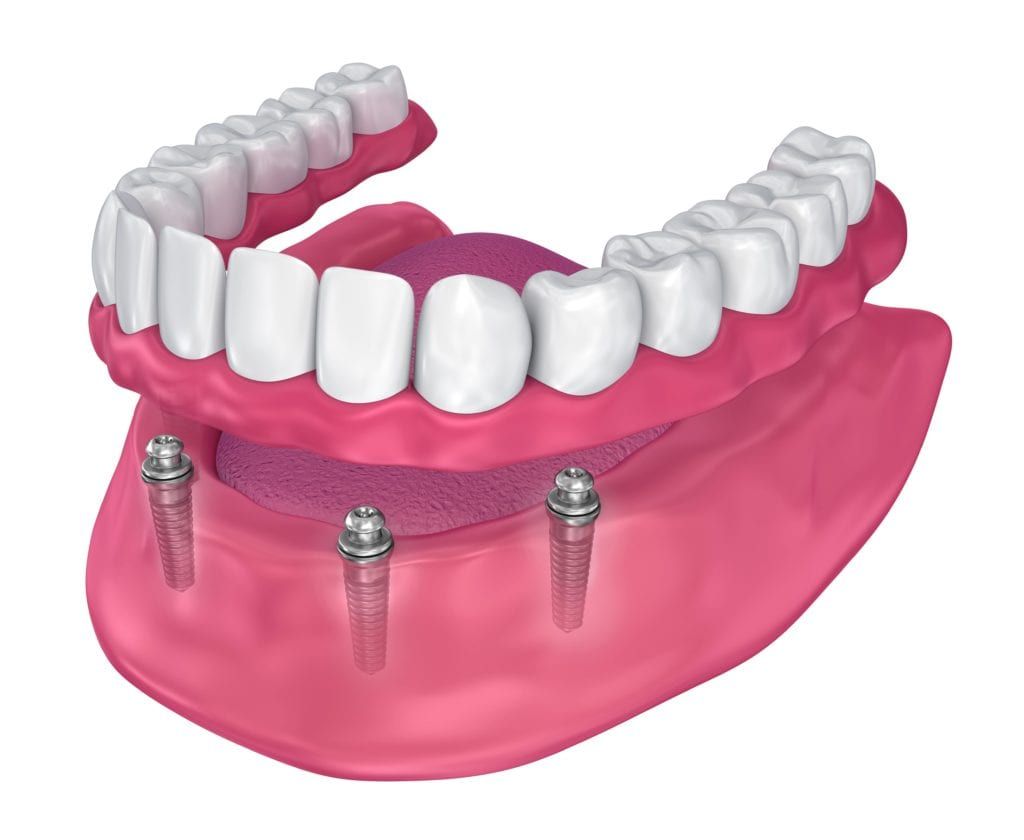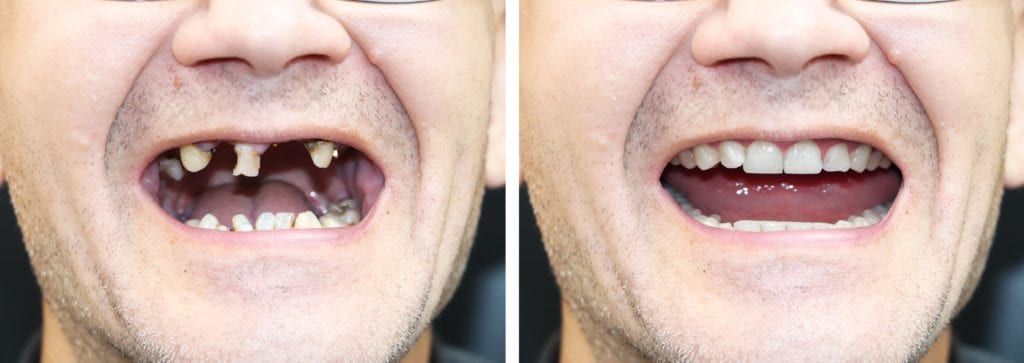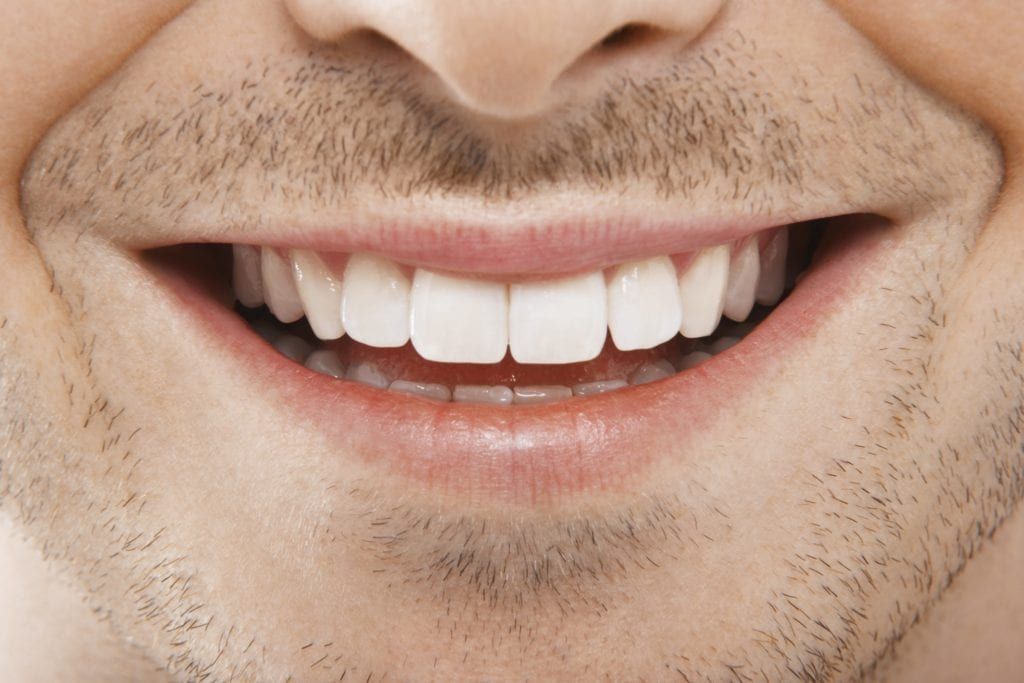Do you have years of dental neglect or a traumatic oral injury standing in the way of a perfect smile? Is it going to take more than a dental filling or dental crown to give you that smile you’ve always dreamed of? Don’t despair any longer! Thanks to modern dental technology, you can still attain a flawless smile even if you are currently reading this with no teeth in your mouth.
For complex restorative and cosmetic dental issues, a full mouth reconstruction or full mouth rehabilitation is often recommended by Dr. Sadati. Full mouth rehabilitation works to improve the dental, skeletal, muscular, and aesthetic structures of your smile. Additionally, full mouth rehabilitation can also help you restore varying levels of chewing and speaking functions.
Sounds too good to be true, right? Luckily, full mouth restorations are very real procedures that Dr. Sadati has extensive experience performing. But, how exactly do full mouth restorations work and is it the best dental treatment for you? Let’s take a closer look.
How does full mouth rehabilitation work?
Simply stated, a full mouth rehabilitation works by replacing multiple teeth on the top an bottom arches of your mouth. Using this procedure, missing teeth can be replaced, a correct bite can be established, and teeth can be protected from excess wear.
To restore and replace damaged, decayed, or missing teeth, a number of dental restorative procedures can be used in a full mouth rehabilitation. The type of restorative procedure used will ultimately vary based on each individual case. For example, for those with damaged teeth may require multiple dental crowns, while those with missing teeth may require dental implants instead.
In cases where there are multiple missing teeth or multiple decayed and damaged teeth, an implant-supported denture may be recommended. Implant-supported dentures used around 4-6 dental implants to support an entire dental arch of teeth. This arch can either be placed on the top, bottom, or even on both jaws, if needed.

Depending on how many teeth are missing or remaining in the mouth, extractions may be necessary prior to the placement of an implant-supported denture. However, if the remaining teeth are healthy, another restoration method may be recommended instead.
In the case of missing teeth, additional reconstructive measures may be required. One common measure is a bone graft. A bone graft places bone material in areas of depleted bone tissue in order to grow new bone over time. Bone grafts are often needed in cases where teeth have been missing for over six months, because bone loss naturally begins to occur at this point. Bone grafts are commonly used in coordination with dental implants, because they help to support the implant and provide additional strength during the healing process.
If dental implants are used on the upper arch, a special type of bone graft called a sinus lift can be used. A sinus lift uses bone grafting material to build up the layer of bone that lies between the upper jaw and sinus cavity. Essentially, this procedure thickens the bone and “lifts” the sinus cavity so that the dental implant can be properly placed with damaging the sinus cavity.
While the aforementioned procedures are some of the more common procedures used for full mouth rehabilitation, there are various other procedures that may be used. These procedures can include:
- Teeth cleaning
- Periodontal scaling & root planing
- Crown lengthening
- Gingival contouring
- Orthognathic surgery
- Orthodontics
Is full mouth rehabilitation right for me?
While only Dr. Sadati can determine for sure if full mouth rehabilitation is the right dental treatment for your individual case, those who generally opt for full mouth rehabilitation often have:
- Multiple missing teeth
- Multiple teeth with failing dental restorations
- Multiple decayed or damaged teeth
- Multiple teeth that are excessively worn
- Ectodermal Dysplasia
- Amelogenesis
- Dentinogenesis Imperfecta
- Undergone severe trauma to the mouth
Most patients seek full mouth rehabilitation to retain or regain chewing and speaking function when their current condition has moderately to severely impacted or threatens to impact it. In some cases, other restoration methods may have worked in the past, but are no longer effective. In other cases, a sudden traumatic event may require significant intervention to restore the mouth to is previous state.

Ultimately, because full mouth rehabilitation has such a wide scope of treatments, it can be the best dental treatment for a variety of dental issues. However, some cases may warrant other dental treatments before starting the process for a full mouth restoration. This is why a thorough dental consultation with Dr. Sadati is required to determine the best treatment plan for each individual patient.
Although we will be touching on this more in the next section, another thing you will want to realize when considering full mouth rehabilitation is that this type of procedure will require a commitment from you as well. To ensure the best treatment outcome you, as the patient will need to commit to following post-treatment directions for an allotted amount of time after your procedure or procedures. When considering if this is the best treatment for you, you will need to be realistic about your ability to commit to your healing.
What can I expect when undergoing a full mouth rehabilitation?
Your exact expectations for your full mouth rehabilitation will vary depending on the specifics of your procedure. Once Dr. Sadati has developed a treatment plan for you, he will discuss his plan, your role, the recovery process, and answer any questions you may have.
As a general rule, full mouth rehabilitation can be moderately invasive and will require your active participation in the treatment for the best outcome. Depending on your treatment plan, multiple treatments may be required, although they may be performed all at once or over a series of months. To ensure treatment success, you will likely be given post-treatment guidelines to follow for a designated amount of time.
Most of the post treatment guidelines deal with things such as taking specific medications, keeping the treatment area clean and free from debris, temporarily adjusting your diet to soft foods, refraining from damaging behaviors, and practicing good daily oral hygiene. Additionally, you will likely be expected to attend regular dental appointments so that Dr. Sadati can monitor your progress and make treatment adjustments as necessary.
Are you ready to meet your new smile? For more information about full mouth rehabilitation, schedule a consultation with Dr. Sam S. Sadati today! Dr. Sam S. Sadati is a South Florida Cosmetic Dentist who is passionate about designing healthy, beautiful smiles for his patients. The Sadati Center for Aesthetic Dentistry proudly serves Wellington and the surrounding communities.


